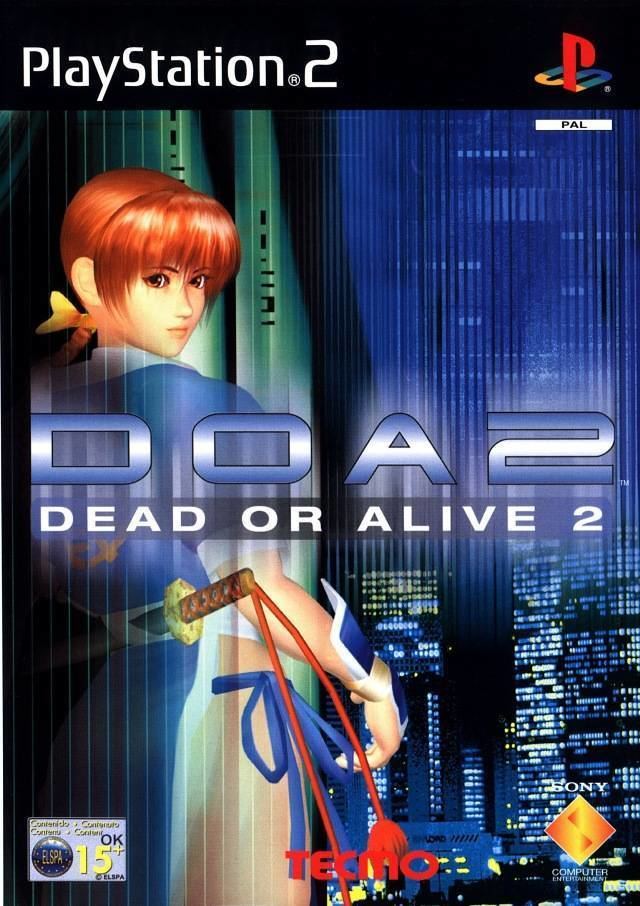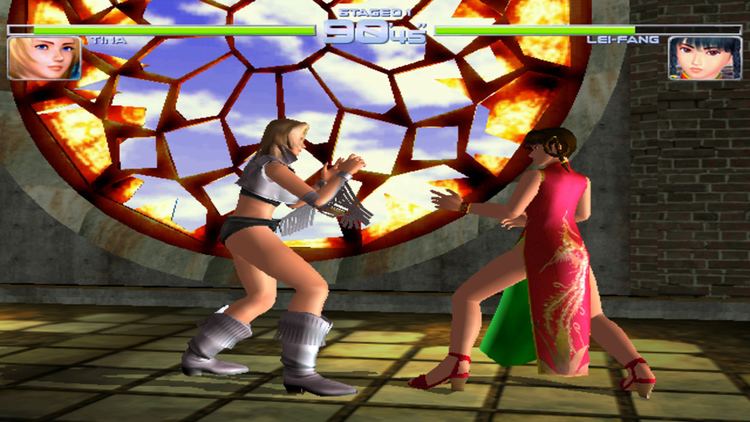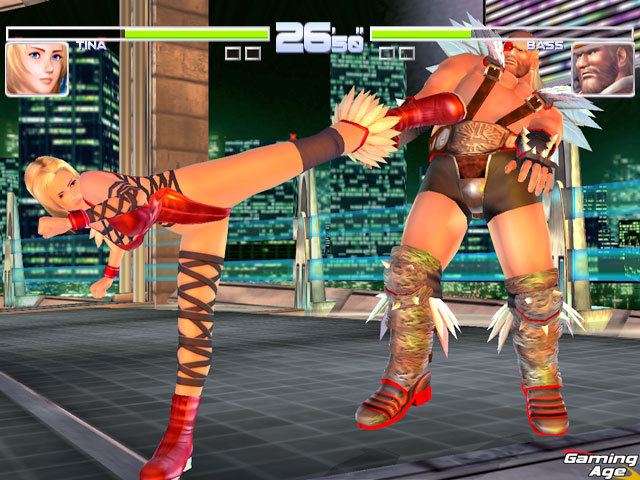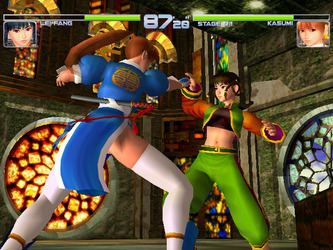9.2 /10 1 Votes
4.6/5 Emuparadise Composer(s) Makoto Hosoi | 9.1/10 GameSpot 4.7/5 CoolROM Initial release date 16 October 1999 | |||||||||||||||||||||||||||||||||
 | ||||||||||||||||||||||||||||||||||
Producer(s) Tomonobu ItagakiYasushi Maeda Programmer(s) Takeshi KawaguchiHiroaki Ozawa Release date(s) ArcadeJP: October 16, 1999January 2000 (Millennium)DreamcastNA: February 29, 2000EU: July 14, 2000JP: September 28, 2000 (Limited Edition)PlayStation 2JP: March 30, 2000NA: October 26, 2000 (Hardcore)JP: December 14, 2000 (Hardcore)EU: December 15, 2000 (Hardcore)PlayStation NetworkJP: August 22, 2012 (Hardcore)NA: March 24, 2015 (Hardcore) Similar Dead or Alive games, Team Ninja games, Fighting games | ||||||||||||||||||||||||||||||||||
Dead or Alive 2 (Japanese: デッドオアアライブ2, Hepburn: Deddo Oa Araibu 2, abbreviated as DOA2) is a fighting game in the Dead or Alive series, developed by Team Ninja and published by Tecmo. It debuted in arcades in 1999 and was later ported for the Dreamcast and the PlayStation 2 in 2000. Several enhanced editions of the game were released, including the updates Dead or Alive 2 Hardcore and Dead or Alive 2 Hard*Core.
Contents

Dead or Alive 2 improved upon the graphics engine of its predecessor by using Sega NAOMI hardware and on the gameplay system by including many new features, leading to critical acclaim and strong sales. In 2004, DOA2 was remade for the Xbox as part of Dead or Alive Ultimate.

Gameplay

The gameplay of Dead or Alive 2, and all subsequent DOA fighting games, borrows heavily from the Virtua Fighter series, but makes some key changes that drastically changes the way Dead or Alive is played in comparison to Virtua Fighter.

In DOA2, the basis of the entire fighting system is the circular relationship between three types of moves: holds, throws, and blows. The other defining feature of the game, aside from holds/throws/blows, is its stun system. Many attacks can inflict a stun on the opponent; those stunned cannot attack or guard, however they can hold. If the attacker lands a non-knockdown, non-launching attack while the opponent is stunned, the opponent will be re-stunned in a new way, depending on what attack was landed.

A major difference between DOA2 and other fighters was in the safety and non-punishability of attacks, both upon hitting and upon being blocked. Most blows in DOA2 can be punished on hit and block by each character's faster throws, making blow-based offense very risky. In addition to the normal rules of juggling, each character also fits into a specific weight category, which affects how the character responds to being launched and being juggled.
In DOA2, fights can occur on either water or ice; when a character is on such a surface, all non-knockdown, non-launching attacks will induce a stun on any successful hit. Walls and falls in the middle of stages are everywhere in the game. Many stages are also multi-tiered: to get to other areas of the stage, one character must be knocked off a ledge and fall into the next area. These falls deal usually fairly high damage, but cannot knock the opponent out.
Other notable features included introducing CG cutscenes in line with the plot, replacing the original "Danger Zone" areas in stages with fully interactive ones, allowing players to juggle each other into walls, propelling characters from landmarks for more damage (the first game to implement this feature was SNK's Samurai Shodown 64), and upon completing the game, presenting the player with (sometimes ambiguous) endings for each character using the game's standard engine.
Characters
Dead or Alive 2 features a total of 14 playable fighters, plus the unplayable Kasumi X. Two of them are unlockable and cannot be used in story mode or in the arcade version. The ten returning characters from the first DOA game are Ayane, Bass Armstrong, Bayman (unlockable), Gen Fu, Jann Lee, Kasumi, Leifang, Ryu Hayabusa, Tina Armstrong, and Zack. The four newcomers are Ein, Helena Douglas, Leon, and Tengu (unlockable boss).
Story
Set less than a year later after the original tournament, a tengu known as Gohyakumine Bankotsubo, or just Tengu, threatens the human world's peace and stability. Kasumi's brother Hayate, previously injured by Raidou, returns from being an unwilling subject of DOATEC's bio-weapon experiment Epsilon as "Ein". Eventually, Ryu Hayabusa (from Ninja Gaiden) defeats Tengu, winning the tournament.
Development and release
The graphics and gameplay were enhanced and based on a better game engine than the one used in the first game, which allowed the characters and stages to appear less angular and more detailed. A popular and commonly discussed feature, one credited to Tomonobu Itagaki, was the level of graphical detail Tecmo put into the animated breasts of the female characters, as Tecmo went so far as to create a physics engine dedicated entirely to the animation of the female characters' breasts.
Dead or Alive 2 used the song "Exciter" by Bomb Factory in its opening sequence. Also used as a background track was "Deadly Silence Beach" and "Clumsy Bird". Both tracks can be found on the self-titled mini-album Bomb Factory and on the Dead or Alive 2 Soundtrack.
Two soundtrack CDs were released in 2000 by Wake Up in Japan: Dead or Alive 2 Original Sound Trax (KWCD-1001) and Dead or Alive 2 Original Sound Trax (KWCD-1004). Several Japanese guide books for the game were published by SoftBank (Dead or Alive 2 Perfect Guide, Dead or Alive 2 Perfect Guide Dreamcast Ban, Dead or Alive 2 Hard Core Perfect Guide) and Dengeki (Dead or Alive 2 Kōshiki Kōryaku Guide, Dead or Alive 2 Kōshiki Kōryaku & Girls, Dead or Alive 2 Hard Core Kōshiki Kōryaku Guide).
Home versions
Itagaki and his team were only given two months initially to produce the first PlayStation 2 port. At the end of this, one of his managers asked to borrow a copy to play, but instead sent in to a production factory. Itagaki was upset by not being able to finish the game on his own terms and fell into a depression during which he briefly considered quitting the industry.
Itagaki and Team Ninja were still dissatisfied with the release versions of DOA2, and continued enhancing it on both the Dreamcast and PlayStation 2 markets as they worked towards their vision of the ultimate fighting game. On October 26, 2000, Tecmo released a last major update titled Dead or Alive 2: Hardcore for the PlayStation 2, which was based on the Japanese and second update of DOA2 for Dreamcast, featuring new playable characters, new stages and extra costumes, and introduced the "Gallery" option.
The Hardcore release features many changes compared to its predecessor. Graphics were altered to appear more realistic, lessening the "anime" look. Some fighting animations were elaborated upon and some were cut. New stages were added (eight more than the Dreamcast update). More character outfits were added. Survival mode now only took place in the "Danger Zone" arena. Overall gameplay speed was increased. The entire game, including cut scenes, runs at a full 60 frames per second (in the Dreamcast version, the game runs at 60 frames/second, while the cut scenes ran at 30). A special "Items Collection" feature and menu section was added to appeal to video game collectors. New artworks were added compared to the first update. A CG Gallery section, featuring renders of the female characters, was added. The player history files were enhanced and now included statistics on how often the player used each character and tag battle pairing. Several special moves were added, but left undocumented. English voice-overs were added in the U.S. and European PlayStation 2 versions, in addition to the original Japanese voice-overs.
Tecmo also followed up on the release of DOA2: Hardcore in the USA and Europe with the release of DOA2: Hard*Core in Japan. This last version saw some minor updates, including new cut scenes, a few new costumes, and a new turbo speed option.
The Dreamcast version has been updated two times, first for the European market with new stages, costumes and cut scenes, and the second time for the Japanese market with a Limited Edition cover art featuring Kasumi and Ayane on the cover along with a standard cover art version with Kasumi, Ayane and Leifang on the cover. This updated Dreamcast version featured two new playable characters, two new stages, stage multipart extensions, new costumes, new cut scenes and the "Gallery" option was introduced. It was later updated with eight new stages, some new costumes and extra gallery artworks and released as Hardcore edition on the PlayStation 2. The new release extended the success of DOA2 in North America and Western Europe, and Dead or Alive became Tecmo's flagship series.
The first PlayStation 2 versions for North America, Europe and Japan were updates of the Dreamcast editions, with a few new cut scenes, costumes and stages added on each localization. Comparing the first and the last home versions of DOA2, namely the Dreamcast American edition and the Japanese Hardcore edition, there are many improvements including an enhanced gameplay and a doubled number of stages and costumes.
In 2012, a software emulated version of DOA2: Hard*Core was made available as a downloadable game on the Japanese PlayStation Network. The North American version was released to PlayStation Network in 2015.
Reception
Dead or Alive 2 was a critical and commercial success. It brought more than $2 million profit in sales. As of 2016, DOA2 has received the best reviews in the series.
At release, the Dreamcast version was met with critical acclaim, while the PlayStation 2 version received positive reviews. It was praised for it's graphics, cutscenes, and gameplay.
GamesRadar included the game on their list of best Dreamcast games, stating that "Dead or Alive's first sequel used separate graphics engines for its fighting and cut-scenes, allowing for unprecedented graphical fidelity." In 2010, UGO.com ranked it as the ninth top fighting game of all time, "perhaps most important for introducing Itagaki's famous breast physics engine."
Remake
Dead or Alive Ultimate is a remake of DOA and DOA2 for the Xbox with a greatly improved graphics engine. As it was created after Dead or Alive 3, it takes elements and mechanics from both its original iteration and successor. The action of 3D-axis movement is as free-formatted as DOA3, and Hitomi, as well as Tengu are now playable characters (albeit outside story mode), but other elements have been kept intact from DOA2. The biggest set of changes instituted in Dead or Alive Ultimate are online play over Xbox Live and the inclusion of slopes, which are a type of environmental hazard.
